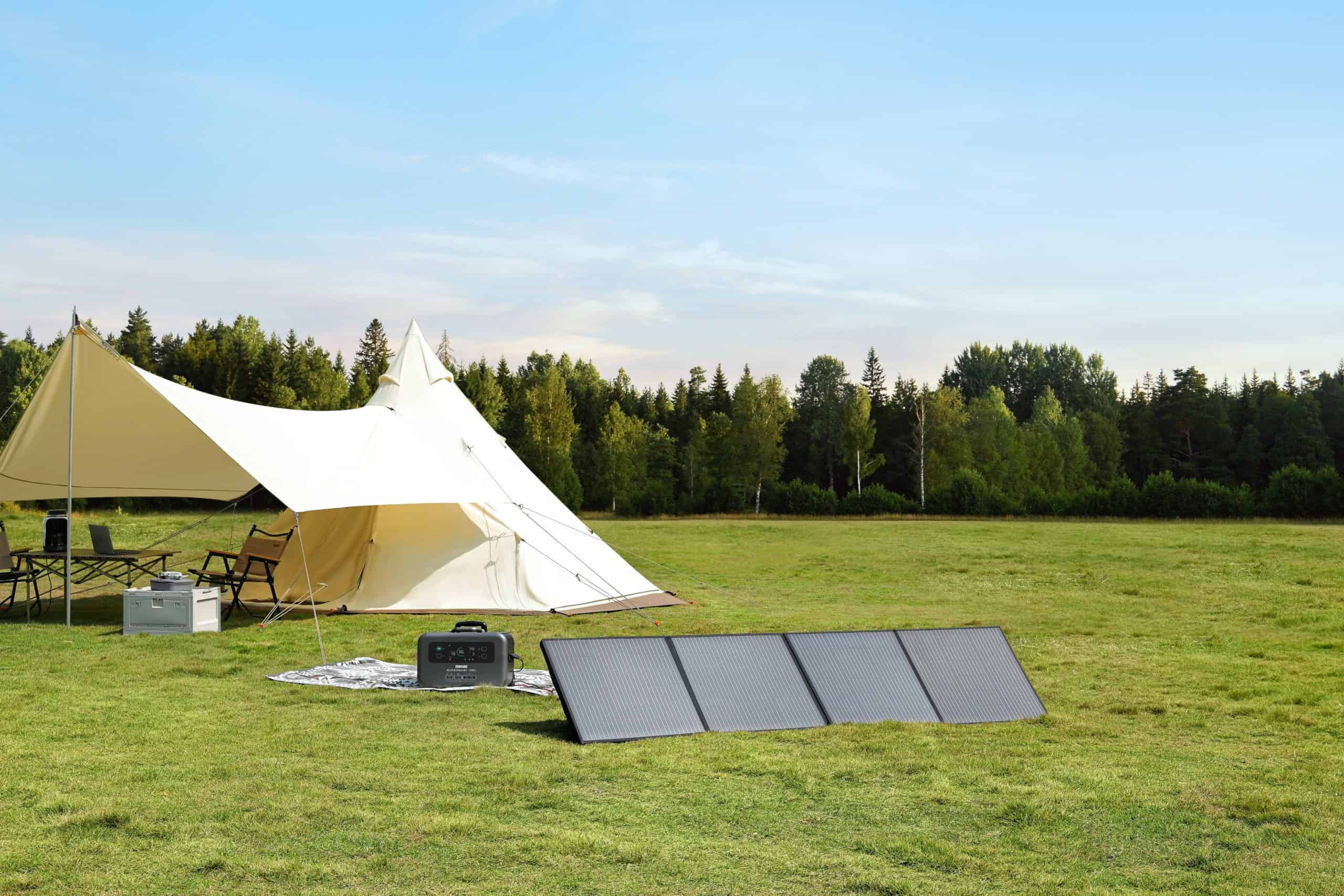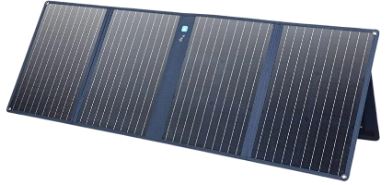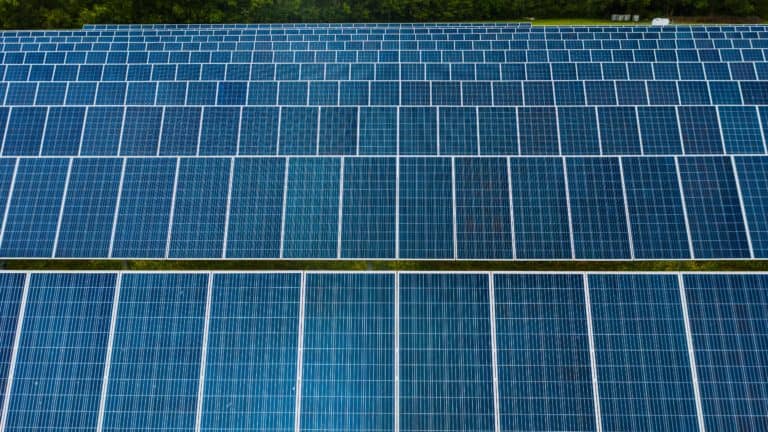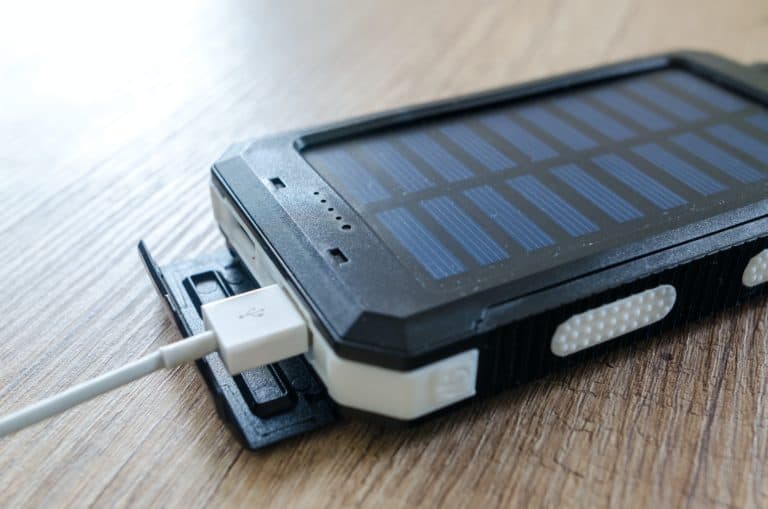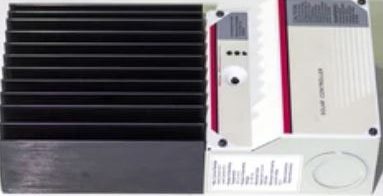The ultimate camping solar panel selection guide
Camping is a fantastic opportunity to commune with nature and relish the great outdoors.
Besides, using a camping solar panel to generate power while enjoying the outdoors is a sustainable, eco-friendly way to generate electricity for your devices and appliances.
As a camping enthusiast, you might want to consider what the benefits of using a solar panel are.
In this comprehensive guide, we will explore various aspects of portable solar panels specifically designed for camping purposes.
This will ensure you make an informed decision when investing in a portable power solution.
We’ll discuss the different types of camping solar panels available in the market, their benefits, and how they work.
We’ll provide tips on selecting the most suitable solar panel for your requirements, taking into account aspects such as effectiveness, portability and price.
You’ll also discover how to properly use and maintain your chosen portable solar panels for camping so that it lasts longer and performs optimally.
What is a camping solar panel?
A camping solar panel is a portable, eco-friendly device that harnesses the sun’s energy to charge electronic camping devices.
These panels are designed specifically for outdoor lovers who want to stay connected while enjoying nature without relying on traditional power sources.
How do they work?
Camping solar panels work by converting sunlight into electricity through the photovoltaic effect. This process involves using solar cells.
These solar cells are made from materials like silicon that absorb photons (light particles) and release electrons, creating an electric current.
The generated power can be employed to juice up gadgets right away or kept in a battery for later use.
Key components of camping solar panels
- Solar cells: These are the primary components responsible for generating electricity from sunlight. They come in various types with differing levels of efficiency.
- Battery pack (optional): Some panels include built-in batteries that store excess energy produced during peak sunlight hours so you can continue charging your devices even when the sun goes down.
- Voltage regulator (or solar charge controller): A voltage regulator ensures consistent output voltage regardless of fluctuations in sunlight intensity throughout the day. This prevents damage to your electronics due to overcharging or undercharging.
- USB ports/charging cables: Most camping panels come equipped with USB ports or other charging cables compatible with popular electronic devices like phones and tablets.
Why choose a camping solar panel?
There are several reasons why investing in a camping solar panel is an excellent choice for outdoor enthusiasts:
- Eco-friendly power source: One of the main reasons people opt for camping solar panels is their environmentally friendly nature. Unlike traditional power sources such as generators or disposable batteries, solar energy produces no harmful emissions or waste products.
- Lightweight and portable design: Camping solar panels are designed with portability in mind. They come in various sizes and weights. However, they are generally lightweight enough for easy transportation during hiking trips or other outdoor activities. Many models also feature foldable designs or built-in handles, making them even more convenient to carry around.
- Versatility: Many camping panels come with adjustable stands or hooks that allow them to be easily attached to backpacks, tents, or trees for optimal sunlight exposure. These panels can power a wide range of devices (smartphones, tablets, cameras, GPS units, fans, lights) during your outdoor adventures.
- Cost savings: There may be an initial investment involved in purchasing a camping solar panel. However, they ultimately save you money over time. This is because the need for disposable batteries or expensive charging stations at campgrounds can be eliminated.
- Emergency preparedness: In the event of an emergency, natural disaster or when in isolated regions, camping solar panels are a dependable energy source to charge critical communication devices like phones and radios when traditional electricity sources are not accessible.
- Low maintenance requirements: Camping panels require minimal maintenance compared to other portable power solutions such as generators. Simply clean the panel surface occasionally and ensure connections are secure. This makes them an ideal choice for those who prefer low-maintenance gear while enjoying nature.
- Education opportunities: Using camping solar panels presents an opportunity to learn more about renewable energy technologies and their potential applications in daily life.
Types of camping solar panels
The two main types are monocrystalline and polycrystalline. It is critical to understand the variations between them before to buying. This is simply because both types have their pros and cons.
Monocrystalline solar panels
Monocrystalline solar panels are composed of pure silicon crystals. These high-quality crystals allow for greater efficiency in converting sunlight into electricity.
Monocrystalline panels typically have an efficiency rate of 15-20%. This means they can generate more power per square inch compared to polycrystalline counterparts.
- Better efficiency: Due to their higher efficiency rates, monocrystalline solar panels produce more energy with less surface area required.
- Sleek appearance: Monocrystalline panels often have a sleek black appearance that many users find aesthetically pleasing.
- Durability: The manufacturing process used for these panels results in increased durability and longevity compared to other panel types.
- Eco-friendly production process: The production process for monocrystals is less wasteful than that of polycrystals. This is because there may be no need to melt multiple silicon fragments together. However, bear in mind that this comes at a cost – literally. Monocrystal production requires more energy input during manufacture due to its purity requirements.
Polycrystalline Solar Panels
Polycrystalline solar panels, also known as multi-crystal silicon panels, are made from melted silicon fragments.
These fragments are then cooled and cut into wafers to create the panel. Polycrystalline panels have an efficiency rate of 13-16%, which is slightly lower than monocrystalline options.
- Lower cost: The production process for polycrystalline solar panels is less expensive, making them more affordable for consumers.
- Variety of sizes and shapes: Due to their manufacturing process, polycrystalline panels can be found in a wider range of sizes and shapes compared to monocrystalline options.
- Better performance in low light conditions: While both types perform well under direct sunlight, polycrystals tend to fare better when faced with low light conditions or partial shading due to its ability to capture energy across multiple angles.
How to choose a camping solar panel
There are several factors you need to consider in order to make an informed decision when selecting a camping panel. These include size, weight, efficiency, and cost.
In addition, think about the type of device you plan on charging with your solar panel and its power requirements.
Size and weight
The size and weight of a camping solar panel are crucial aspects when determining portability.
You’ll want something compact enough that won’t take up too much space in your backpack but still provides sufficient surface area for efficient energy conversion from sunlight into electricity.
Keep in mind that larger panels typically offer more power output. However, they can be bulkier and heavier than smaller options.
Foldability and weather resistance
A good portable solar panel should be easy to transport and set up at your campsite. Foldable solar panels are an excellent choice because they can be compactly stored when not in use.
Furthermore, ensure that your foldable solar panels have adequate weather resistance features like waterproofing or UV protection.
This is because outdoor conditions during camping trips can be unpredictable.
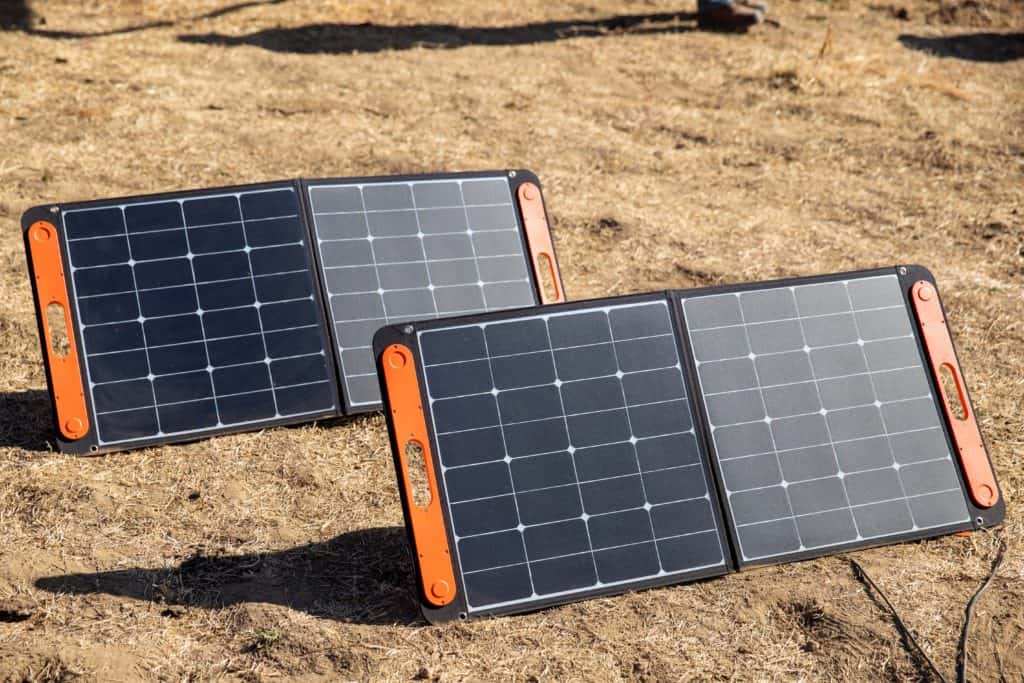
Efficiency
Solar panel efficiency refers to how well the panel converts sunlight into usable electrical energy for your devices.
Monocrystalline panels tend to boast a higher efficiency rating (around 15-20%) than polycrystalline models (roughly 10-15%).
This means monocrystalline panels will charge your devices faster under similar conditions but may come at a higher price point due to their advanced technology.
Cost
Your budget is another important factor when choosing flexible or foldable solar panels.
While high-quality panels with greater efficiency might seem like the best option initially, they can also be quite expensive compared to less-efficient alternatives such as polycrystalline models or even flexible thin-film types which are cheaper yet provide lower performance levels.
Compare the advantages and disadvantages of each type to determine which is most suitable for your needs and budget.
Device compatibility
Consider the types of devices you’ll be charging with your camping solar panel.
Some panels come equipped with USB ports for easy connection to smartphones, tablets, or other USB-compatible gadgets.
Others may require an additional adapter or charge controller to regulate voltage output for compatibility with various electronics (source).
Power output
The power output of a camping solar panel is measured in watts (W). The more watts, the quicker it can replenish your gadgets.
To accurately assess the power output of a camping solar panel, take into account the total energy consumption of all devices you intend to charge. For example:
- A smartphone requires approximately 5-10W
- A tablet might need around 15-30W
- Laptops typically demand between 45-60W
In summary, a well-designed camping solar power system with a triple or quadruple panel setup should provide enough energy for most common devices used during a camping trip.
Some examples include:
- Fans: Ceiling fans help keep air circulating inside tents while also providing some relief from hot temperatures outdoors.
- Lights: Solar-powered LED lights ensure that campsites remain illuminated after dark without relying on traditional batteries or generators.
- Mini-fridges: A portable solar power system can keep your food and drinks cold. This can reduce the need for ice packs or coolers.
- Water Heaters: Solar energy can be used to heat water for showers, washing dishes, or cooking purposes.
- Electronics: Adequate solar power generation allows you to charge devices like cell phones, laptops, tablets, and cameras during your camping trip.
When choosing flexible solar panels, consider factors such as size, weight, efficiency, cost, device compatibility and power output. Monocrystalline panels charge devices faster but come at a higher price point than polycrystalline models.
Calculating your energy needs
- Determine which appliances/devices you’ll need during the trip: Make a list of everything you plan on using while camping – from cellphones to water heaters – so you know what kind of power output is required.
- Analyse each device’s wattage requirements: Check product specifications or user manuals for information about how much electricity each item consumes per hour/day.
- Add up total daily usage: Multiply individual wattages by hours used per day then sum them up to get your total daily energy consumption.
- Factor in surge watts: Some devices, like power tools or air conditioners, require a higher wattage when starting up. Make sure your solar system can handle these temporary spikes in demand.
How to use a camping solar panel
By following these simple steps, you can harness the power of the sun for all your charging needs.
A. Positioning your solar panel
- Find the right spot: To get optimal performance from your camping solar panel, place it in direct sunlight with minimal obstructions such as trees or buildings that could cast shadows on the panel.
- Orient towards the sun: Ensure that your solar panel faces directly towards the sun at an angle perpendicular to its rays. This maximises energy absorption and increases charging efficiency.
- Maintain exposure throughout the day: As you enjoy your outdoor activities, periodically adjust the position of your solar panel so it continues facing towards the sun as it moves across the sky.
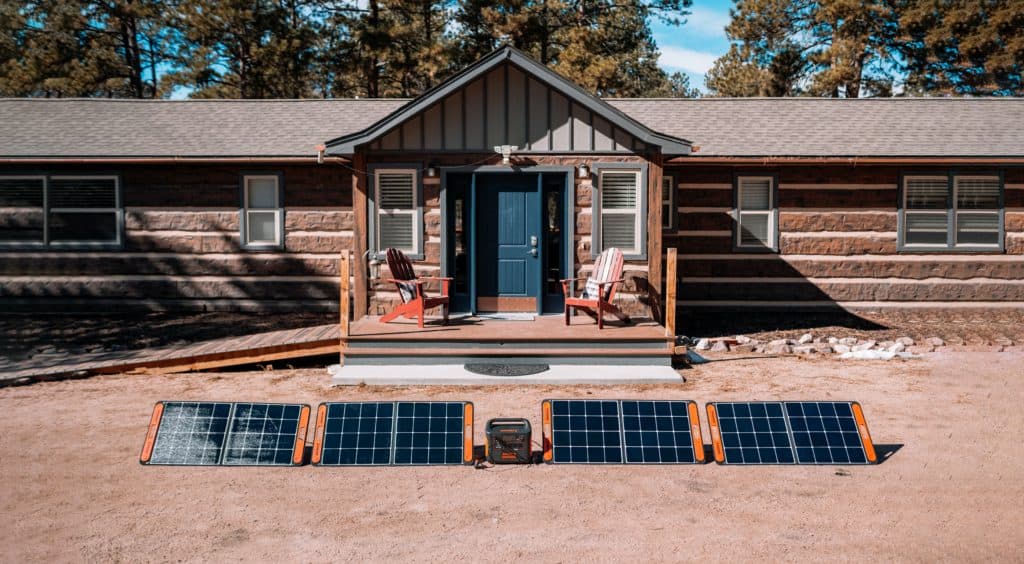
B. Connecting your devices
To charge devices using a camping solar panel, follow these guidelines:
- Select an appropriate cable: Most panels come equipped with USB ports for easy connectivity; however, some may require specific cables or adapters depending on their output options and device compatibility (e.g., laptops).
- Determine if additional accessories are needed: Some devices might need extra components like voltage regulators or battery packs for successful charging via a solar panel. REI’s expert advice on solar chargers can help you understand the requirements of your specific device.
C. Monitoring charging progress and safety
While charging devices with a camping solar panel, keep these safety tips in mind:
- Avoid overheating: Never leave your electronic devices unattended while charging under direct sunlight. This could lead to overheating or fire hazards. Periodically check the temperature of both the panel and connected devices to ensure they remain within safe operating ranges.
- Maintain proper ventilation: Ensure that there is adequate airflow around your solar panel and connected devices during charging sessions. This is especially crucial if using them inside a tent or other enclosed space.
- Monitor charge levels: Regularly check the battery status of your connected device(s) to avoid overcharging or draining their batteries completely. Unplug them once fully charged or when not in use for extended periods.
Next, we’ll discuss some tips for maintaining your camping solar panel in order to keep it running smoothly and efficiently.
To effectively use a solar panel for camping, it should be positioned in direct sunlight with minimal obstructions and oriented towards the sun. Devices can be connected using appropriate cables, but extra components like voltage regulators or battery packs may be needed for successful charging.
Connecting components for efficient usage
To maximise the efficiency of your flexible solar panel system, it’s essential to connect it properly with other components such as batteries, regulators (also known as a solar charge controller), and inverters.
This ensures that the energy generated by your panels or a solar array is used effectively, reducing waste and promoting environmentally-friendly practices during camping trips.
- Batteries: Connecting your flexible panels to a portable power station or a solar battery allows you to store excess energy for later use when sunlight isn’t available.
- Solar regulator: A solar regulator (or charge controller) helps manage the flow of electricity between your solar panel and battery, preventing overcharging or damage to either component.
- Inverter: An inverter converts the direct current (DC) produced by your panels into alternating current (AC), which can be used to generate electricity for most household appliances and electronic devices while camping.
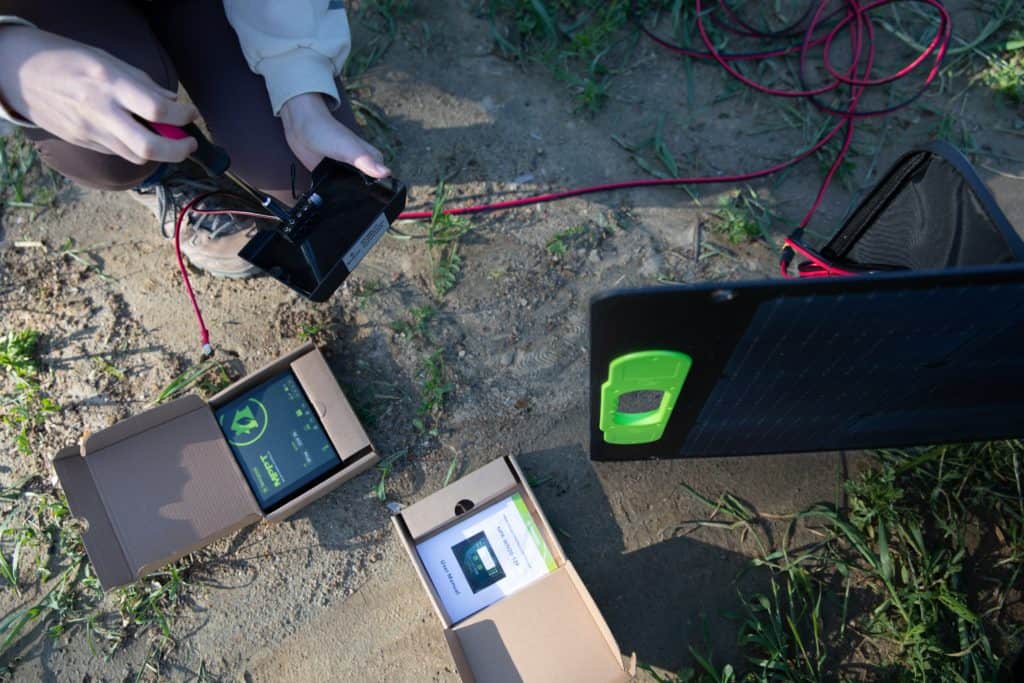
Build your own battery box
If you prefer a more customised approach to your camping solar power setup, consider building your own battery box using individual components such as an inverter, a regulator, and a solar battery.
This option allows you to tailor your solar array system according to your specific needs and preferences.
Here are some noteworthy products that can help you build an efficient portable power station for your next camping trip:
Jackery SolarSaga 60
The Jackery SolarSaga 60 is known for its easy setup and effective device charging even under cloud cover.
This lightweight solar charger boasts high-efficiency monocrystalline panels, allowing for the charging of small electronics like phones, tablets and laptops in the course of a typical sunny day.
GoSun Panel-30
The GoSun Panel-30 features two conductive layers made from different types of silicon cells which offer enhanced performance compared to traditional thin film panels.
Its foldable design makes it easy to transport and store when not in use while providing ample energy generation capabilities for various electronic devices on a camping trip.
FEELLE Portable Power Bank
This compact yet powerful FEELLE Portable Power Bank has four smaller panels capable of generating up to 25 watts of electricity.
It folds down into a size slightly larger than a smartphone making it ideal for backpacking or hiking trips where space is limited but access to solar energy is essential.
Connect the solar panels to a charge controller that regulates electricity flow and prevents overcharging or damage.
Next, you’ll need an inverter that converts direct current (DC) power generated by the panels into alternating current (AC) power suitable for use with most electronic devices.
Finally, you’ll want a reliable and efficient battery storage system that can store excess energy during periods of strong sunlight for later use when the sun shines less brightly.
In addition to these components, consider investing in accessories like mounting brackets and cables designed specifically for portable solar panel setups.
These will ensure secure installation and optimal performance while promoting environmentally-friendly practices during your camping adventures.
Maintenance tips for camping solar panels
Maintaining your portable panels is essential to ensure their longevity and optimal performance during your outdoor adventures.
To ensure the longevity and optimal performance of your camping solar panel, regular maintenance is key.
Clean your solar panel
Debris, dirt, and dust can build up on the solar panel’s surface with time, leading to decreased productivity.
To clean it effectively:
- Utilise a delicate fabric or soft-bristled brush to delicately clear away any soil or particles from the surface.
- Avoid using harsh chemicals or abrasive materials that could damage the panel’s protective coating.
- If necessary, use a mild soap solution with water to clean stubborn stains or grime. Rinse thoroughly with clean water afterwards.
- Allow the panel to air dry completely before storing it away or using it again.
Storing your solar panel
To prolong the life of your camping solar panel and prevent potential damage when not in use:
- Store the solar panel in a cool, dry environment away from direct sunlight and high temperatures.
- Avoid placing heavy objects on top of the solar panel as this may cause cracks or other damage.
- If possible, store them inside their original packaging which usually provides adequate protection against scratches.
- You should also consider investing in a protective case or cover designed specifically for camping panels.
Regular inspection
Regular inspection of your portable panels and solar charger can help identify any potential issues before they become major problems.
Make sure to:
- Check the connections and cables for signs of wear, fraying, or damage.
- Ensure that all connectors are securely attached and functioning properly.
- If you notice any loose parts or damaged components, contact the manufacturer for repair options or replacement parts as needed.
Avoid overcharging your devices
To prevent overheating and potential fire hazards while using your camping solar panel:
- Avoid leaving your devices unattended during charging.
- You should also use an external battery pack which allows you to charge multiple devices simultaneously without overloading the panel.
- In addition, it’s important to monitor weather conditions such as extreme heat which could affect both the efficiency of your solar panel and safety when charging electronic devices outdoors.
Now let’s look at some safety considerations when using these panels while out on the trail.
To maintain the longevity and optimal performance of your solar panel, it is important to regularly clean it with a soft cloth or non-abrasive brush. Store it in a cool, dry place away from direct sunlight and extreme temperatures, inspecting its connections and cables for signs of wear.
Safety considerations
While solar panels for camping are an eco-friendly and convenient way to keep your devices charged during outdoor adventures, it’s essential to prioritise safety when using them.
Here are the necessary safety precautions to take when using a camping solar panel:
Avoid high temperatures and direct sunlight
Camping solar panels work best in direct sunlight; however, exposing your electronic devices to high temperatures for extended periods can cause damage or reduce their lifespan.
To prevent overheating:
- Place the device in a shaded area or under a protective cover while charging.
- Avoid leaving the device by itself for extended periods.
- Regularly check the temperature of your device and disconnect it from charging if it is too hot.
Secure your panel against strong winds
In windy conditions, lightweight panels may become unstable or even blow away.
Ensure that your panel is securely anchored by following these tips:
- If possible, place rocks or other heavy objects around the edges of the panel.
- Tie-down loops are available on some models – use them with stakes or guy lines for added stability.
If strong winds persist and pose a risk to your equipment, consider temporarily disassembling and storing your camping solar panel until conditions improve.
Maintain proper connections
To avoid potential hazards such as short circuits or fires due to damaged cables:
- Regularly inspect the charging cables and connectors for signs of wear or damage.
- Replace any damaged components immediately.
- Avoid using makeshift connections or adapters that are not designed for your specific panel model.
Water safety
Camping solar panels are often water-resistant but not fully waterproof. To protect your equipment from water damage:
- Avoid submerging the panel in water, even if it’s labelled as “water-resistant.”
- Keep the panel away from damp surfaces and avoid placing it directly on wet ground.
In case of rain, disconnect your device and store both the panel and device in a dry place until conditions improve.
Battery storage precautions
If you’re using a camping solar panel with an integrated battery pack:
- Be cautious about where you store it – extreme temperatures can cause batteries to degrade more quickly.
- Avoid storing the battery near flammable materials or sources of heat.
Taking these safety precautions will help ensure that you have a positive experience while using camping solar panels during your outdoor adventures.
Be aware of potential risks, including excessive heat, powerful gusts of wind and wrong connections to ensure a secure and beneficial experience with solar energy for camping.
When using a camping solar panel, it’s important to prioritise safety. Avoid exposing your devices to high temperatures and direct sunlight for extended periods, secure your panel against strong winds, maintain proper connections, and be cautious about water exposure and battery storage precautions.
Popular camping solar panel options
When it comes to choosing the perfect camping solar panel, there are several popular options available on the market.
These panels offer excellent performance and portability, ensuring that you have a reliable source of power during your camping trip.
Anker 625
The Anker 625 is a highly efficient portable solar panel designed for charging devices like smartphones and tablets.
During testing on a cloudy day, this impressive device managed to charge a phone by 5 per cent in just five minutes.
Its compact size makes it an ideal choice for campers who need to keep their gadgets charged without taking up too much space in their backpacks.
Lion 50W foldable
If you’re looking for something with more power output capacity, consider the Lion 50W Foldable.
This versatile option provides enough juice to charge both phones and laptops alike within just 22 minutes.
This foldable option is also conveniently portable, allowing for easy storage and transportation.
EcoFlow’s delta 2 solar generator +220W portable solar panel bundle
For those seeking an all-in-one solution, look no further than EcoFlow’s Delta 2 Solar Generator +220W Portable Solar Panel bundle.
This bundle includes the necessary components for creating power from the sun’s rays, such as solar panels, batteries and inverters.
This plug-and-play set-up offers a convenient way to get electricity in sunny areas.
Once you’ve calculated your energy needs and considered the essential features mentioned above, explore popular options such as the Anker 625, Lion 50W Foldable, or even build your own battery box using components like inverters, regulators, and batteries from brands like Jackery SolarSaga60 or GoSun Panel-30.
Wrapping up
By reading this article, you have learned about the benefits of using a solar panel for camping purposes, the different types available in the market, and how to choose one that best suits your needs.
You have also learned how to use and maintain your camping solar panel properly while keeping safety considerations in mind.
Investing in and buying portable solar panels for your outdoors is not only good for our environment, but it can also save you money on energy costs in the long run.
So why not make a sustainable choice today?
FAQs
Are Solar Panels Worth It for Camping?
Yes, solar panels are worth it for camping. They provide a clean and renewable source of energy to power electronic devices, reducing reliance on fossil fuels or disposable batteries.
They can also save money in the long run by eliminating the need to purchase fuel or replace batteries frequently.
What Do Solar Panels Do for Camping?
Solar panels convert sunlight into electricity during camping trips, allowing campers to charge their electronic devices such as smartphones, cameras, and portable lights.
This helps maintain communication with others and enhances overall safety while enjoying outdoor activities without access to conventional power sources.
What Type of Solar Panel Is Best for Camping?
The best type of solar panel for camping is a lightweight and foldable monocrystalline panel due to its high-efficiency rate and portability.
These types of panels typically have built-in USB ports or adapters that make them compatible with various electronic devices commonly used during outdoor adventures.
How Many Watts of Solar Do I Need for Camping?
The number of watts needed depends on your specific energy requirements during the trip. As a general guideline, 50-100W should be sufficient for charging small electronics like phones and cameras; however, if you plan on powering larger items such as refrigerators or air conditioners, you may require 200W or more.
